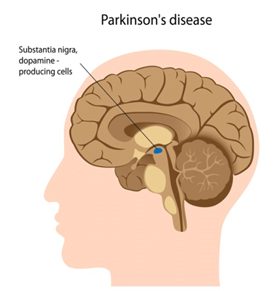Dance for Parkinson’s – what is Parkinson’s
Parkinson’s Disease is a neurodegenerative disorder. A neurodegenerative disorder is when cells in the central nervous system (the brain and the spinal cord) stop working or die. In Parkinson’s disease, a part of the brain called the substantia nigra (part of the basal ganglia) is affected. The substantia nigra produces a chemical called dopamine, that is important in helping us plan body movements and control unwanted movements. In Parkinson’s disease, these dopamine-producing cells die and are not replaced.

Rama Raju, Venkateshwarla et al. (2020). IP Indian Journal of Neurosciences. 6. 202-219. 10.18231/j.ijn.2020.041.
What symptoms do people with Parkinson’s have?
Common symptoms in people with Parkinson’s Disease include:
- Tremors.
- Slow movements.
- Rigidity in the muscles.
- Freezing when walking.
- Smaller movements (e.g. shuffling steps).
- Reduced balance and as a result, increased falls.
Exercise for Parkinsons
Although there is no cure for the disease, physiotherapy and exercise intervention have been shown to be effective in treating the symptoms of Parkinson’s Disease. One study found that high dosage exercise appears to strengthen the basal ganglia circuits, and has the potential to modify the progression of the disease.
Incorporation of cueing into therapy has been shown to be very effective. Cueing may include playing a metronome sound as a person walks, or putting markers on the ground. The visual and/or auditory stimulus allows sends the messages in the brain along a different pathway (i.e. uses a different part of the brain), which helps improve the motor symptoms above.
Why Dance for Parkinson’s?
Considering the above, dance therapy can be beneficial for people with Parkinson’s Disease. Not only does the music naturally incorporate auditory cueing, but dancing also targets balance, coordination, endurance and strength. As dancing requires use of the entire body, all the major muscle groups in the body are used. Also, dancing in a group gives people the opportunity to access the community and socialise, which has been shown to improve quality of life. Although Dance therapy is commonly used for Parkinson’s Disease, it is beneficial for many people with other neurological conditions and can be implemented into your treatment. You can find more about Parkinson’s Disease and physiotherapy here. Here at Sunshine Coast Neuro Rehab, our Sunshine Coast Physiotherapists understand you and your condition. We support people with neurological conditions to achieve more function, greater independence and quality of life. If you are interested to learn more about dance therapy, or would like to make an appointment, please make a booking by calling (07) 5448 115 or email admin. Kira Odling Evidence: Abbruzzese, G., Marches, R., Avanzino, L., & Pelosin, E. (2016). Rehabilitation for Parkinson’s disease: Current outlook and future challenges. Parkinsonism and Related Disorders, 22, 560-564. DOI: Hackney, E., Bennet, C. G. (2014). Dance therapy for individuals with Parkinson’s disease: improving quality of life. Journal of Parkinsonism and Restless Legs Syndrome, 4, 17-25. DOI: https://doi.org/10.2147/JPRLS.S40042 De Natale, E. R. et al. (2017). Dance therapy improves motor and cognitive functions in patients with Parkinson’s disease. NeuroRehab, 40(1), 141-144. Retrieved from: https://content.iospress.com/articles/neurorehabilitation/nre1399
Physiotherapist, APA Member
